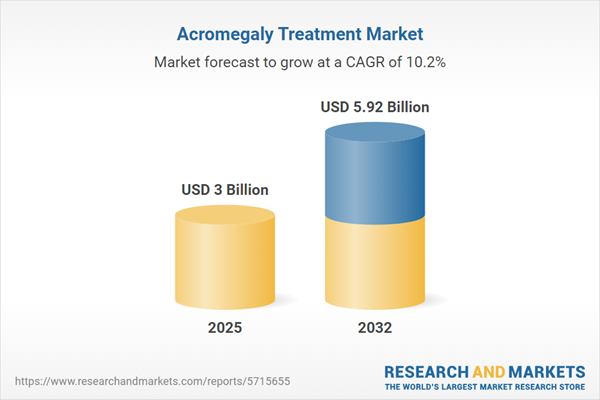Speak directly to the analyst to clarify any post sales queries you may have.
Senior decision-makers evaluating the global acromegaly treatment market operate within a fast-evolving sector shaped by advances in patient care, therapy delivery, and market competition. Staying informed and agile is crucial to capitalizing on emerging opportunities and strengthening organizational strategy in this changing healthcare landscape.
Market Snapshot: Global Acromegaly Treatment Market Size and Growth
The global acromegaly treatment market is valued at USD 2.72 billion and is expected to expand at a compound annual growth rate of 10.20%. This significant growth trajectory is propelled by regular updates to clinical protocols, greater investment from healthcare stakeholders, and the widespread adoption of innovative disease management solutions. Key market drivers include the rapid integration of novel therapies and enhanced collaboration between healthcare providers and payers, improving patient access and outcomes. Shifting regulatory conditions and evolving patient populations across regions further increase the need for adaptable strategy and operational excellence.
Scope & Segmentation: Core Pillars of the Acromegaly Treatment Market
This report delivers actionable insights for executive teams by segmenting the acromegaly treatment market according to therapeutic modalities, routes of administration, distribution channels, and end-user profiles. Analysis also covers leading companies and global regional dynamics to help senior leaders refine their strategies.
- Treatment Type: Combination therapies, dopamine agonists, growth hormone receptor antagonists, radiotherapy, somatostatin analogs, and surgical interventions all play critical roles. Long-acting and personalized regimens are increasingly prioritized for optimized patient outcomes and adherence.
- Route of Administration: Intramuscular, subcutaneous, and oral formats support flexible care protocols, enabling care tailored to individual needs, including for decentralized and home-based settings.
- Distribution Channel: Hospital pharmacies, digital health outlets, and retail avenues ensure comprehensive supply chain performance and improve therapy access across varied care environments.
- End User: Hospitals, specialty clinics, and homecare services serve both institutional and self-management patients, each contributing unique operational models for scaling quality care.
- Geographic Coverage: Market analysis covers regions including the Americas, Europe, Middle East, Africa, and Asia-Pacific, with specific focus on the UK, Germany, France, China, India, Japan, Australia, and Southeast Asia.
- Key Companies Profiled: Leading players such as Ipsen S.A., Novartis AG, Pfizer Inc., Chiasma, Inc., and Recordati S.p.A. are profiled, highlighting their innovation pathways and approaches to expanding market access worldwide.
Key Takeaways for Senior Decision-Makers
- Integrated, interdisciplinary care models are increasingly important, driving collaboration across clinical specialties and improving treatment effectiveness for acromegaly patients.
- Advancements in diagnostic technologies, including improved imaging and biomarker tools, enable earlier patient identification and support more personalized therapeutic interventions across healthcare systems.
- The expanding options for both injectable and oral therapies offer healthcare providers enhanced flexibility in designing care pathways, accommodating traditional clinical workflows as well as remote and home-based care models.
- Growth in biosimilar and generic product availability broadens procurement choices for organizations, requiring regular evaluation and optimization of supply and distribution networks in response to regulatory and market developments.
- Continuous updates to compliance standards and trial operations necessitate proactive regulatory management and collaboration between manufacturers, providers, and payers to mitigate risk and ensure product viability across diverse markets.
- Investments in digital health infrastructure and local manufacturing expand resilience within the supply chain, supporting the integration of telehealth services and remote patient monitoring for diverse healthcare settings.
Tariff Impact: Adjusting to US Tariff Policy and Supply Chain Changes
Recent shifts in US tariff policy have prompted pharmaceutical manufacturers to adjust their production and sourcing strategies. This adaptation accelerates trends toward domestic manufacturing and dynamic pricing structures, leading to increased supply chain resilience, greater cost predictability, and enhanced long-term patient access in a fluctuating trade environment.
Methodology & Data Sources
The report compiles evidence through validated secondary research complemented by input from experts in endocrinology, surgery, pharmacy, and reimbursement. Regulatory evaluations, clinical trial data, and patient feedback converge to create a comprehensive perspective for all major healthcare stakeholders.
Why This Acromegaly Treatment Market Report Matters
- Empowers senior leaders to prioritize innovative therapies, digital solutions, and evolving regulatory strategies within the acromegaly treatment market, supporting agility in decision-making.
- Facilitates competitive benchmarking and measured risk assessment, informing operational and expansion strategies for organizations operating in both established and emerging markets.
- Delivers evidence-based recommendations for regional managers, equipping teams to implement access initiatives and achieve sustainable market growth objectives.
Conclusion
This report provides leaders with a robust framework for aligning organizational objectives and processes, strengthening resilience, and supporting progress as the acromegaly treatment market advances toward more patient-centered care models.
Additional Product Information:
- Purchase of this report includes 1 year online access with quarterly updates.
- This report can be updated on request. Please contact our Customer Experience team using the Ask a Question widget on our website.
Table of Contents
3. Executive Summary
4. Market Overview
7. Cumulative Impact of Artificial Intelligence 2025
Companies Mentioned
The companies profiled in this Acromegaly Treatment market report include:- Ipsen S.A.
- Novartis AG
- Pfizer Inc.
- Chiasma, Inc.
- Recordati S.p.A.
Table Information
| Report Attribute | Details |
|---|---|
| No. of Pages | 189 |
| Published | October 2025 |
| Forecast Period | 2025 - 2032 |
| Estimated Market Value ( USD | $ 3 Billion |
| Forecasted Market Value ( USD | $ 5.92 Billion |
| Compound Annual Growth Rate | 10.2% |
| Regions Covered | Global |
| No. of Companies Mentioned | 6 |









